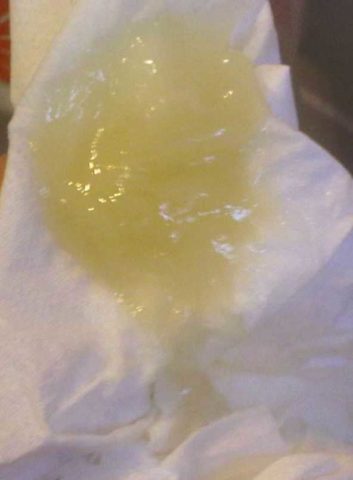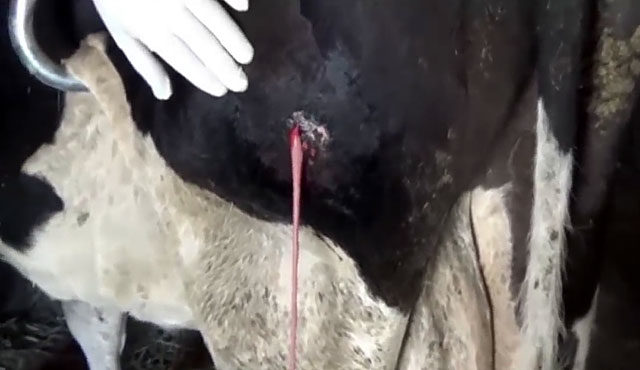Content
Calving of a cow is an important stage in the pregnancy of an animal, which ends with the birth of a calf. This is a complex process and can have some consequences for the heifer. In order to recognize possible troubles in time and help the body to recover, every livestock breeder should know how the labor is going on, how long it takes for a cow to bleed after calving, and what is considered a normal variant.
Discharge from a cow before calving
Even before the calf is born, the cow's body begins to prepare for an important event. Changes occur that need attention, such as bleeding. They may talk about an imminent hotel or the threat of premature birth.
When pre-calving discharge begins
When the calf is ready to be born, a characteristic discharge can be observed from the cow's genital tract. They can appear a day before calving, which is normal for a first-calf. In an adult animal, this time period is shortened. As a rule, discharge speaks of imminent birth, the calf will appear in 12-15 hours.
What discharge may be before calving
Normally, before calving, cervical mucus is released from the genital tract of a cow, which lubricates the birth canal. This is necessary for the comfortable advancement of the fetus.
From the moment when the cow begins to discharge, the heifer must be under constant control. Immediately before childbirth, a watery liquid leaves her - these are water. They may contain minor impurities or blood clots.
Such discharge is considered the norm and accompanies the process of childbirth. However, this only happens when the calf is moving head first. If the position of the fetus is incorrect or some kind of disturbance has occurred, then the discharge from the cow has an uncharacteristic color, becomes bloody.
What discharge before calving is not the norm
A pink or brown discharge before calving in a cow is considered abnormal. It is also bad when there are blood impurities in the mucus. This suggests that while moving along the birth canal, the calf injured the blood vessels. However, this condition is not a threat to the calf's life. The blood vessels regenerate quickly. Immediately after calving, the uterus is carefully examined, disinfecting solutions are injected and antibacterial suppositories are prescribed.
It is much worse if the discharge becomes bloody. This already speaks of intrauterine bleeding. You cannot cope with such a situation on your own. Childbirth requires surgery. Blood discharge may indicate:
- improper position of the fetus;
- ruptured uterus;
- vaginal injuries.
In the first case, they try to turn the fetus over with their hands, otherwise an operation will be required.
Blood discharge requires immediate diagnosis. They can develop directly in the uterus or in the vagina. After calving, the birth canal is washed and examined. Vaginal bleeding goes away without clots. The presence of such indicates an intrauterine rupture.
In this case, you need to help the cow immediately.The afterbirth is separated, and all actions are directed to the contraction of the uterus. The cow is injected with "Oxytocin", a hormone that constricts the blood vessels. The injection is done under the skin. Ichthyol and sodium chloride are given intravenously. Next, put on a bandage and apply a heating pad with ice. After calving, treatment with vitamins is prescribed for at least 5 days intramuscularly.
When there is a lot of bleeding during calving, antimicrobial therapy is used to prevent the development of infections. If the drugs cannot be administered intravenously, then this is done with the help of an enema pear.
Discharge from a cow after calving
Normally, after calving, each cow begins blood lochia, which helps the uterus to cleanse and contract. If the birth took place without complications, then they will not last long. In case of ruptures and other violations, the period of cleansing and healing is delayed.
How much discharge can go after calving
Immediately after calving, there is a bleeding from the vagina, which in a healthy cow will last 14 days. On the 15th day, they should completely stop.
What discharge can be after calving
However, in the first three days, the lochia is bloody, bright, reminiscent of fresh blood. Gradually they acquire a slimy character, turn white and stop. At the same time, the animal feels well, no external changes occur, the body temperature is normal, and the appetite is healthy.
What discharge after calving is not the norm
If, after calving, the cow's discharge differs from those described, has impurities of yellow secretion or purulent blotches, then this indicates the development of a pathological process. Complications after parturition lead to serious illnesses:
- vaginitis;
- endometritis;
- metritis.
Therefore, it is simply necessary to monitor the nature of the lochia in the first few days. This will help to recognize the disease at the first stage and will allow treatment to begin on time.
Vaginitis is manifested by white or yellow lochia, absence of blood exudate. The disease provokes an inflammatory process in the vagina. If you do not pay attention to this in time, then the lochia gradually from the mucous membranes become granular, bloody. After the diagnosis is confirmed, the vagina is washed, treated with a solution of potassium permanganate and smeared with ichthyol ointment. Ichthyol-soaked swabs can be inserted. In the complex, a course of antibiotics and vitamins is prescribed, which must be distributed along with the feed.
Endometritis is a serious inflammatory disease of the uterus in cows. The disease penetrates into different layers of the organ, therefore, there are several types of it. When only the mucous membrane of the uterus is affected, a simple endometritis can be stated. When muscle tissue is damaged, they speak of myometritis. If the disease affects the peritoneum, then we are talking about perimetritis. And only as a last resort, when, in addition to the uterus, the ligaments and adjacent tissues suffer, parametritis develops. At the same time, at different stages of the disease, the cow has uncharacteristic bleeding.
Purulent lochia that occurs after calving is a sign of purulent-catarrhal endometritis. In this case, the discharge has an unpleasant putrid odor. The disease develops within 8 days after calving. All this time, the animal is depressed, eats food poorly, the amount of milk decreases, the body temperature rises slightly. Gradually, the picture becomes clearer, the discharge becomes more abundant instead of declining. Treatment of purulent inflammation of the uterus is prescribed by a veterinarian, injections of "Oxytocin" and "Rifapol" are often administered.
Dirty yellow bloody discharge with an unpleasant odor indicates fibrous endometritis. At the same time, the cow feels good after calving, but the secreted fluid has a yellow tint with flakes.If measures are not taken in time, then sepsis may develop.
In the case of severe calving, necrotizing metritis develops. The inflammatory process affects muscle tissue, which disrupts its nutrition. Cell necrosis occurs, erosion and ulcers appear. Microbes enter the bloodstream and cause inflammation in any organ of the animal. Outwardly, this condition is manifested by blood secretions mixed with crumbs. The cow is depressed:
- high body temperature;
- no appetite;
- rapid heartbeat;
- the uterus is painful.
Against the background of everything, severe diarrhea and mastitis can develop. If treatment is not started on time, paralysis can occur.
In advanced cases, metritis develops - a dangerous condition for the animal, leading to death in the first days. At the same time, the cow has strong bloody, almost black, discharge of a mushy consistency with pus and a musty odor. The uterus is compacted, painful to the touch, does not contract, and is filled with exudate.
Treatment for this condition should be urgent. First of all, fluid is pumped out of the uterine cavity, after which the organ is washed with bactericidal solutions. The remaining liquid is sucked out by vacuum. The uterine cavity is filled with antimicrobial drugs. Foaming agents give good results. Along the way, they begin to introduce antibiotics.
How to avoid unpleasant discharge after calving: prevention
To prevent the development of complications after calving, you need to regularly examine pregnant cows, monitor their nutrition and prepare them for childbirth.
After calving, a thorough examination for infections is recommended so as not to miss the onset of endometritis or vaginitis. Vitamin complexes, which are pierced just before childbirth, will help reduce the risk of pus in the uterine cavity. They stimulate the immune system and increase the body's resistance.
Conclusion
Bloody discharge from a cow after calving may be a normal option if it gradually decreases in intensity. Otherwise, they indicate the onset of inflammation. Treatment of the animal must be started immediately.










